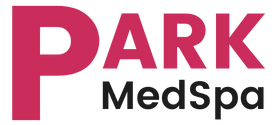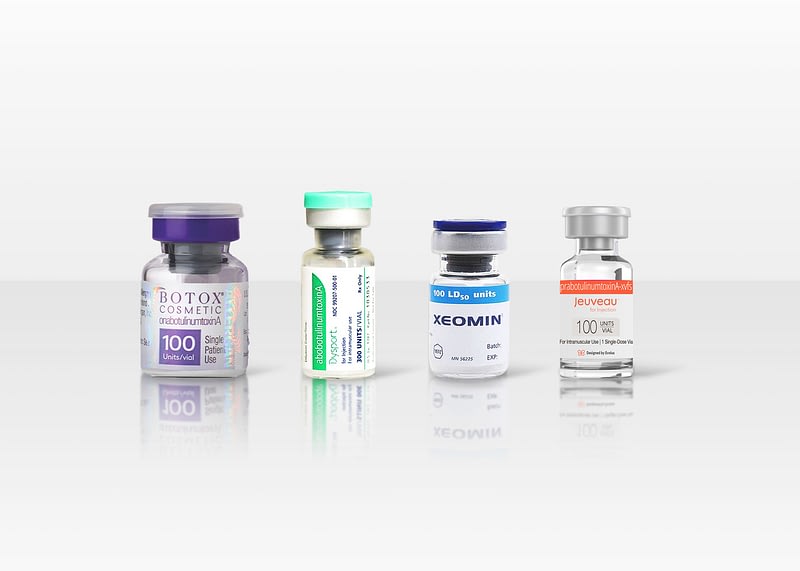Summary
- Based on research data, all four FDA-approved neurotoxins are effective and well-tolerated.
- Botox, Jeuveau, and Xeomin are equivalent in units.
- Dysport is dosed in higher units.
- Xeomin has a purification manufacturing process and does not need refrigeration.
- Xeomin has a lower price for medical practices from the manufacturer.
In 2021, FDA has approved 4 neurotoxins for use to reduce the wrinkles in the frown lines between the eyes. Let’s go over each of the Botulinum Toxins and find the difference between them. Although our focus is on the Xeomin Challenge, we will give you an unbiased opinion on the 4 neurotoxins. Then, you’ll understand why we decided on Xeomin.
What are The Different Botulinum Toxins?
Botox = ONAbotulinumtoxin A
Dysport = ABObotulinumtoxin A
Xeomin = INCObotulinumtoxin A
Jeuveau = PRAbotulinumtoxin A
Botulinumtoxin A (“BoNT-A”) is a purified strain of Botulinum Toxin.
The different prefixes “Ona,” “Abo”, “Inco,” and “Pra,” indicate the differences in the biologic properties of each Botulinum Toxin.
Which One is Better?
This is a question that we get asked ALL OF THE TIME. For the sake of impartiality, let we show you a chart with many of the research publications that compare one toxin vs another
| Title | Conclusion | Winner |
| Botox, Dysport, Xeomin | ||
| A mixed treatment comparison to compare the efficacy and safety of botulinum toxin treatments for cervical dystonia | Based on this MTC analysis, there is no significant efficacy difference between Dysport, Botox, Xeomin and Myobloc at week four post injection. | None |
| Conversion Ratio between Botox®, Dysport®, and Xeomin® in Clinical Practice | ONA and INCO have comparable efficacies with a 1:1 conversion ratio and have demonstrated therapeutic equivalence in different indications including cervical dystonia and blepharospasm. An ONA to ABO conversion ratio ≤1:3 should be considered the most appropriate. | None |
| A Quantitative Analysis of OnabotulinumtoxinA, AbobotulinumtoxinA, and IncobotulinumtoxinA: A Randomized, Double-Blind, Prospective Clinical Trial of Comparative Dynamic Strain Reduction | Using digital image correlation, the tested neuromodulators do not have equivalent strain reduction in the glabella at the doses used. These results confirm assertions of noninterchangeability. | None |
| Onset and duration of effect of incobotulinumtoxinA, onabotulinumtoxinA, and abobotulinumtoxinA in the treatment of glabellar frown lines: a randomized, double-blind study | IncobotulinumtoxinA demonstrated a more rapid onset and a longer duration of treatment effect than onabotulinumtoxinA (1:1 dose ratio) and abobotulinumtoxinA (1:3 dose ratio). | Xeomin |
| Botox vs. Dysport | ||
| Prospective Randomized Comparison of OnabotulinumtoxinA (Botox) and AbobotulinumtoxinA (Dysport) in the Treatment of Forehead, Glabellar, and Periorbital Wrinkles | Results showed no statistically significant differences between the two agents. Both agents yielded measurable improvements on wrinkles of the upper face at 150 days. | None |
| Efficacy of Onabotulinum Toxin A (Botox) versus Abobotulinum Toxin A (Dysport) Using a Conversion Factor (1 : 2.5) in Treatment of Primary Palmar Hyperhidrosis | The efficacy and safety of Botox and Dysport injections were similar using a conversion factor of 1 : 2.5. There was a trend towards a more rapid action after Dysport treatment but without significant importance. | None |
| Dysport and Botox at a ratio of 2.5:1 units in cervical dystonia: A double‐blind, randomized study | The mean change of the Toronto western spasmodic torticollis rating scale score, the proportion of improvement in clinical global impression and patient global impression, and the incidences of adverse events were not significantly different between the two treatments. With regard to safety and efficacy, Dysport was not inferior to Botox in patients with CD at a conversion factor of 2.5:1. | None |
| A Single-blind, Split-face, Randomized, Pilot Study Comparing the Effects of Intradermal and Intramuscular Injection of Two Commercially Available Botulinum Toxin A Formulas to Reduce Signs of Facial Aging | There was no statistically significant difference between onabotulinumtoxinA and abobotulinumtoxinA when injected intradermally or intramuscularly. | None |
| A Randomized Double-Blind Study of the Effect of Botox and Dysport/Reloxin on Forehead Wrinkles and Electromyographic Activity | The results of the present study show that Dysport/Reloxin has a longer duration of effect on EMG activity and forehead wrinkles than does Botox at a unit dose conversion ratio of 3:1 | Dysport |
| Respective potencies of Botox and Dysport: a double blind, randomised, crossover study in cervical dystonia | Dysport 1:3 (and Dysport 1:4 to a greater extent) is more efficient than Botox for both impairment and pain in cervical dystonia although with a somewhat higher incidence of minor adverse effects. | Dysport |
| Botox vs. Xeomin | ||
| A direct comparison of onabotulinumtoxina (Botox) and IncobotulinumtoxinA (Xeomin) in the treatment of benign essential blepharospasm: a split-face technique | No difference between Xeomin and Botox was detected in either subjective or objective measures for the treatment of BEB. | None |
| Comparison of preferences between onabotulinumtoxinA (Botox) and incobotulinumtoxinA (Xeomin) in the treatment of benign essential blepharospasm | This study demonstrates that patients who prefer incobotulinumtoxinA over onabotulinumtoxinA had a statistically significant shorter treatment interval. In addition, those who preferred incobotulinumtoxinA thought it was more effective, whereas those patients who preferred onabotulinumtoxinA thought it had a longer duration. | None |
| Xeomin® vs. Botox® A Side-by-Side Comparison in the Same Patients | Xeomin® and Botox® are equal unit for unit as might be expected by their common 150 kDa active neurotoxin. | None |
| Comparing Botox® and Xeomin® for axillar hyperhidrosis | Side-to-side differences of the therapeutic effect (onset latency, extent, duration) were neither detectable by the patient nor by the physician. | None |
| Measuring the potency labelling of onabotulinumtoxinA (Botox(®)) and incobotulinumtoxinA (Xeomin (®)) in an LD50 assay | Although the existence of a conversion ratio has been questioned recently, our experimental data are in line with previous clinical experience showing that Botox(®) and Xeomin(®) can be compared using a 1:1 conversion ratio. | None |
| Routine use of Xeomin in patients previously treated with Botox: long term results | There were no diffusion differences between Botox and Xeomin. Using a conversion ratio of 1:1 Xeomin and Botox can easily be exchanged in a continued treatment. | None |
| Noninferiority of IncobotulinumtoxinA, Free from Complexing Proteins, Compared with Another Botulinum Toxin Type A in the Treatment of Glabellar Frown Lines | Analysis of the data confirmed the noninferiority of incobotulinumtoxinA. | None |
| Double-blind, randomised, parallel group pilot study comparing two botulinum toxin type A products for the treatment of blepharospasm | No significant differences between products were noted in PGA and adverse events at the doses used in this study. | None |
| A Randomized, Double-Blind Trial to Investigate the Equivalence of IncobotulinumtoxinA and OnabotulinumtoxinA for Glabellar Frown Lines | Equivalence was demonstrated at the primary endpoint between incobotulinumtoxinA and onabotulinumtoxinA in the treatment of GFL at the 20 U dose at 1 month. Similar efficacy and tolerability profiles were observed through 4 months after treatment. | None |
| A prospective rater- and subject-blinded study comparing the efficacy of incobotulinumtoxinA and onabotulinumtoxinA to treat crow’s feet: a clinical crossover evaluation | IncobotulinumtoxinA and onabotulinumtoxinA (1:1 dose conversion ratio) were well tolerated, showing comparable efficacy and duration of treatment effect for crow’s feet. | None |
| Xeomin vs. Dysport | ||
| A Prospective, Neurophysiologic Comparative Study to Assess the Efficacy and Duration of Effect of IncobotulinumtoxinA and AbobotulinumtoxinA in the Treatment of Crow’s Feet | In conclusion, for treatment of crow’s feet, incobotulinumtoxinA and abobotulinumtoxinA (1:3 dose) demonstrated comparable efficacy in terms of magnitude and longevity of effect. Both products demonstrated a high responder rate, with the response being maintained for 6 months in the majority. | None |
| Botox vs. Jeuveau | ||
| A Multicenter, Randomized, Double-Blind, Placebo-Controlled, Single-Dose, Phase III, Non-Inferiority Study Comparing PrabotulinumtoxinA and OnabotulinumtoxinA for the Treatment of Moderate to Severe Glabellar Lines in Adult Patients | A single treatment of 20 U prabotulinumtoxinA was safe and effective and noninferior to 20 U onabotulinumtoxinA for the treatment of moderate to severe glabellar lines. | None |
There are a few studies that state that Dysport at a higher dilution rate (3:1) had better outcomes than Botox. There is one study that states that Xeomin had a better outcome than Botox.
Our best conclusion based on the data is that all four are effective and well-tolerated. A much larger double-blind clinical study needs to be performed before anyone Botulinum Toxin company can claim superiority. Anecdotally, we have not seen anyone Botulinum Toxin perform better than the others to smooth fine lines and wrinkles. They are not interchangeable, but they have similar efficacy and safety.
What is The Unit Equivalence?
Another common question is: If I get 20 units of Botox on my frown line, then how much of the other neurotoxins should I get?
Based on the package insert, here is the equivalent amount:
Botox 20 units
Dysport 50 units
Xeomin 20 units
Jeuveau 20 units
However, one research article suggests that the following should be the optimal equivalent amount:
Botox 20 units
Dysport 40 – 60 units
Xeomin 20 units
Is One Purer Than Another?
Xeomin is the only currently FDA-approved Botulinum Toxin that uses the XTRACT Technology that removes unnecessary proteins. Xeomin contains only the core neurotoxin protein without other accessory proteins. In clinical trials, none of the 2650 patients developed secondary treatment resistance due to neutralizing antibodies. What does this mean? Well, a very small number of patients can build up neutralizing antibodies against Botulinum Toxin and accessory proteins. This can cause the patient to require a higher dose. In rare cases, the patient becomes immune to the Botulinum Toxin completely. So, in theory, Xeomin may be less immunogenic than the other Botulinum Toxins.
Are There Different Handling Requirements?
Xeomin is the only currently FDA-approved Botulinum Toxin that does not require refrigeration prior to reconstitution.
Why Choose Xeomin Over Botox, Dysport, and Jeuveau?
All four Botulinum Toxins are generally accepted to have equal efficiency and safety. We decided to participate in the Xeomin Challenge, because Xeomin has an additional layer of purity, and is easier to handle due to the lack of refrigeration requirements. Finally, the Xeomin Challenge offer of $99 for 20 units provides patients a great opportunity to try a different Botulinum Toxin.


